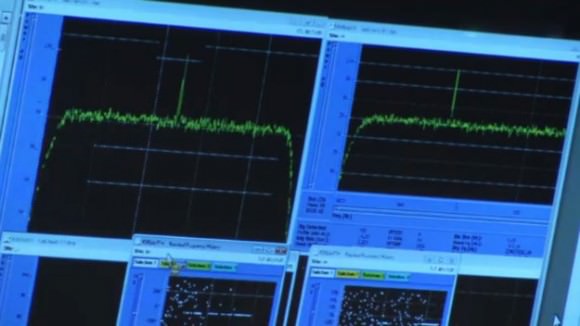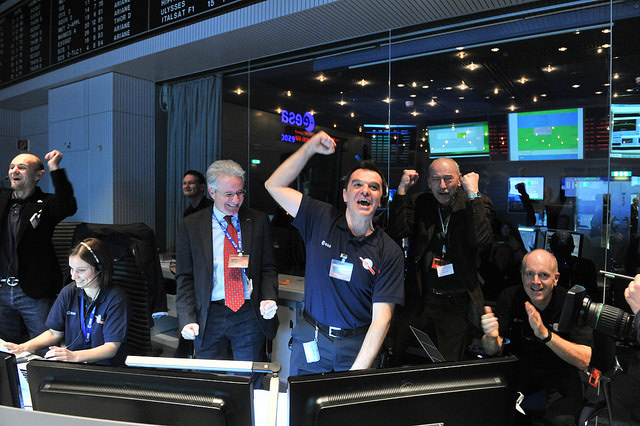The silence from the live video feed from the ESA’s space operations center in Darmstadt, Germany was almost deafening. Scientists and engineers were waiting to receive a signal from the Rosetta spacecraft, which was supposed to come out of hibernation today to begin its mission to Comet 67P/Churyumov-Gerasimenko in earnest. Finally, after waiting nearly 45 minutes into the window of time when the spacecraft was supposed to send a signal, a little blip appeared on the screens of the spectrum analyzers and the room erupted in cheers.

“After waiting over two and a half years, what is three-quarters of an hour!” said Fred Jansen, ESA’s Rosetta mission manager. “The spacecraft is there, it’s awake and the science team knows there are two busy years ahead of them. Now we have to work hard. Thanks to the team that achieved this.”
“I think I can speak on behalf of everyone here and everyone on Twitter: that was rather stressful!” said Matt Taylor, Rosetta project scientist. “The work begins now and I think we’ll have a fun-filled two years ahead, so let’s get on it!”
Soon after the signal arrived, the mission Twitter feed came alive, Tweeting “Hello World” in multiple languages.
Labas, pasauli!
— ESA Rosetta Mission (@ESA_Rosetta) January 20, 2014
My antennas started tingling a few hours ago with all the shouting and wonderful #wakeuprosetta messages. Thank you!
— ESA Rosetta Mission (@ESA_Rosetta) January 20, 2014
Later in the day, as the team checked out the spacecraft, everything appeared in order and working well as systems began to start operating:
#Rosettta Operations Manager Andrea Accomazzo has taken a look at the data… we look good!
— ESA Operations (@esaoperations) January 20, 2014
Rosetta was placed into hibernation in June 2011, with only the computer and several heaters remaining active as the spacecraft cruised out to nearly 800 million km from the warmth of the Sun, beyond the orbit of Jupiter.
Today, as Rosetta’s orbit came back to within 673 million km from the Sun, there was enough solar energy to power the spacecraft fully again and Rosetta’s pre-programmed internal ‘alarm clock’ woke up the spacecraft after a record 957 days of hibernation. After warming up its key navigation instruments, coming out of a stabilizing spin, and aiming its main radio antenna at Earth, Rosetta sent a signal to let mission operators know it had survived the most distant part of its journey.
The signal was received by NASA’s Goldstone ground station in California at 18:18 GMT during the first window of opportunity the spacecraft had to communicate with Earth.
The one-way light time on today, January 20, 2014 between Rosetta and Earth was about 44 minutes and 53 seconds over a distance of 807,224,610.74 km. Rosetta was about 9,188,540 km from the comet, closing up at about 800 m/second.
“This was one alarm clock not to hit snooze on, and after a tense day we are absolutely delighted to have our spacecraft awake and back online,” said Jansen.
Comets are considered the primitive building blocks of the Solar System and perhaps may have helped to ‘seed’ Earth with water, or even the ingredients for life. But many fundamental questions about these enigmatic objects remain, and through its comprehensive, in situ study of Comet 67P/Churyumov-Gerasimenko, Rosetta aims to unlock the secrets contained within.
“All other comet missions have been flybys, capturing fleeting moments in the life of these icy treasure chests,” said Taylor. “With Rosetta, we will track the evolution of a comet on a daily basis and for over a year, giving us a unique insight into a comet’s behavior and ultimately helping us to decipher their role in the formation of the Solar System.”
So schön! #WakeUpRosetta Flug frei für @Philae2014. Der Lander soll im November auf dem Kometen aufsetzen (AS) pic.twitter.com/ZlN9ZhIQJP
— DLR_de (@DLR_de) January 20, 2014
But first, essential health checks on the spacecraft must be completed. Then the eleven instruments on the orbiter and ten on the lander will be turned on and prepared for studying Comet 67P/Churyumov-Gerasimenko.
“We have a busy few months ahead preparing the spacecraft and its instruments for the operational challenges demanded by a lengthy, close-up study of a comet that, until we get there, we know very little about,” says Andrea Accomazzo, Rosetta operations manager.
Rosetta’s first images of 67P/Churyumov-Gerasimenko are expected in May, when the spacecraft is still 2 million km from its target. Towards the end of May, the spacecraft will execute a major maneuver to line up for its critical rendezvous with the comet in August.
After rendezvous, Rosetta will start with two months of extensive mapping of the comet’s surface, and will also make important measurements of the comet’s gravity, mass and shape, and assess its gaseous, dust-laden atmosphere, or coma. The orbiter will also probe the plasma environment and analyse how it interacts with the Sun’s outer atmosphere, the solar wind.
Using these data, scientists will choose a landing site for the mission’s 100 kg Philae probe. The landing is currently scheduled for November 11, 2014 and will be the first time that a landing on a comet has ever been attempted.
With almost negligible gravity from the comet’s 4 km-wide nucleus, Philae will have to use ice screws and harpoons to stop it from rebounding back into space after touchdown.
Among its wide range of scientific measurements, Philae will send back a panorama of its surroundings, as well as very high-resolution pictures of the surface. It will also perform an on-the-spot analysis of the composition of the ices and organic material, including drilling down to 23 cm below the surface and feeding samples to Philae’s on-board laboratory for analysis.
The focus of the mission will then move to the ‘escort’ phase, during which Rosetta will stay alongside the comet as it moves closer to the Sun, monitoring the ever-changing conditions on the surface as the comet warms up and its ices sublimate.
Rosetta will follow the comet throughout the remainder of 2015, as it heads away from the Sun and activity begins to subside.
You can read the team’s blog about the “wake up” here, and find out more about the Rosetta mission here.
Here’s a replay of the acquisition of signal:


The first question will be: How far are we off target?
Second question: How much did the internal clock deviate?
No more than a couple of milliseconds, I think. She’s not cruising at such a high speed.
Can Philae also use rocket thrusters to keep it on the surface of the comet in case rebound does occur despite the mechanisms in place to prevent that from happening?
Push-down and hold-down thrusters are used to accelerate descent and impede rebound after touchdown.*
*Source: NSSDC – PHILAE.
Thanks IVAN3MAN
So Rosetta was 45min late waking up. So what? I also like hitting snooze when it’s cold out.
Not late waking up. “Into the window”.
This means that maybe the heating of the star cameras were slow because of power available, a subsystem needing 2 boots, it needed to turn further than anticipated to face the sun head on… it’s been a long time since it fired any thrusters to get on course… It could be something else entirely.
This was 100% a success.
One small blip from Rosetta – one giant leap for humanity.
I’d be more impressed with “Oh, god… where’s the coffee?”
Nice!